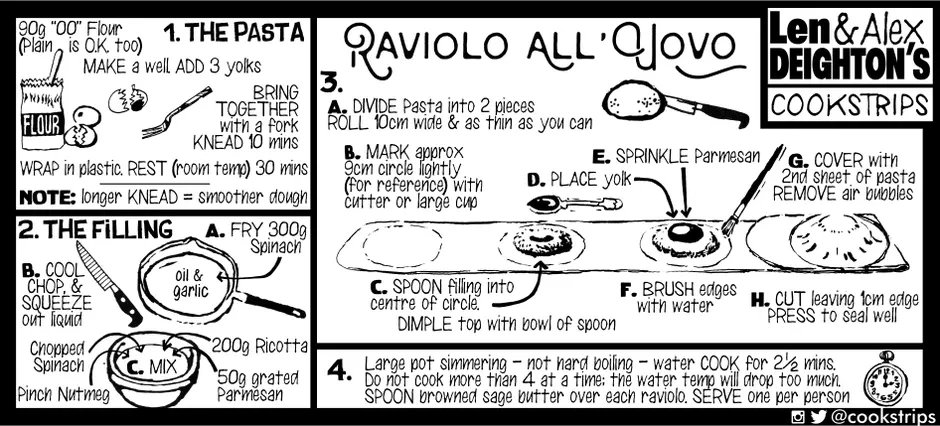
I imagine that if someone asked my wife, Trish, the name of the cookbook I appreciate best, she would look at that person with amazement. There is none. My name is totally dissociated with the act of cooking.
Part of the reason for this, is my childhood culinary education. It was limited to learning how to prepare a pot of tea, and serving it with milk and sugar. Through observation, I also learned to fry an egg. I would however, like to thank my maternal Grandmother, Jane Andison (nee Briggs, 1880 – 1972) for teaching me how to bake bread. Another part of this challenge is an inability to understand the details of a meal preparation timeline. I have a theoretical appreciation of it as a process with several finishing lines, commonly involving the serving of courses, as in appetizers, main course and desert with coffee or tea. A main course may involve up to several distinct dishes, using an assortment of animal, vegetable and fungal (mushroom) ingredients. Each dish has its own duration, in terms of preparation time and cooking time.
Over the past forty years, I have learned some basic skills. Main courses with three dishes, are no longer an insurmountably problem. Typically, at least for someone with my qualifications, there will be, at most, one desert. No appetizer will be offered.
This complexity means that for a given meal there will be numerous start times for the various dishes, and a limited number of locations (6 in total: 4 on the stove top, one in the oven, and one in the microwave oven) to cook them. Everything has to be planned. Some of the equipment may have to be washed up to several times, which adds yet another level/ dimension to the confusion.
Len Deighton (1929 – ) originally drew cookstrips as instructions to himself to prevent his expensive cookbooks from becoming dirty. Ray Hawkey, a graphics designer for The Observer, noticed some of these cookstrips in Deighton’s kitchen. The first cookstrip, Cooking Beef: Part 1, appeared in The Observer on 1962-03-18. They became part of its magazine-like look. An initial commitment for six strips was soon extended to 50. The last cookstrip in this series appeared on 1966-08-07.
These cookstrips were then recycled into Len Deighton’s French Cooking for Men: 50 Classic Cookstrips for Today’s Action Men. The first edition appeared in 1965, timed to coincide with the release of The Ipcress File film. In the film, a cookstrip appears on the wall behind the protagonist, Harry Palmer, played by Michael Cain, who appears to crack eggs with one hand. In reality the hands cracking the eggs belonged to Deighton.
A new, redesigned and updated edition of this book was republished 2020-02-01 in paperback. The publisher, HarperCollins, claimed that it, “will solve the mysteries of French cuisine and unlock the key to 500 memorable dishes.” This version is currently out of print.
Illustrated cookstrips from Deighton and his son Alex, have re-emerged in the Observer more than 50 years after the original series. They were relaunched 2017-04-23: New cookstrips appear at about monthly intervals.
Unfortunately, even if I had purchased Deighton’s cookbook in my youth, 1965 – 1970, I doubt if it would have transformed me. Today, I am even less fond of excessive eating, and the consumption of alcohol, which seems to be an integral part of French cooking. However, the making of cookstrips with a focus on Scandinavian cuisine does hold appeal.
Sources
- A taste of the action: Len Deighton’s cult Sixties’ cookbook is back
- Len Deighton’s Observer cookstrips, Michael Caine and the 1960s
There will be a post about cooking once a month in 2022.


Cooking is a challenge that becomes easier with experience. At first one may need to write out a list of ingredients and the order in which to do things, but as you get more experience, it may all be done in the head. I often start with what time I want to serve the meal and work backwards to when things have to be started. For example, pasta that needs to be cooked for 10 minutes plus the time to heat the water (this has to be figured out on your stove), gives the time you need to turn the water on.
I would not recommend turning on all six items you mentioned at the same time. You may overload the circuits in the house and increase the electricity bill. Turn them on one at a time and once they are turned down, turn on the next one. It takes time and practice to get to know your stove and to know what level of heat you need to do various types of cooking.
Good luck with your cooking in the future, and not just writing about it.
Jane sent me some comments that I felt other people might appreciate:
The Len Deighton cookstrips you describe and picture remind me of the James Barber books published [in Canada]. Earliest, I think, was Ginger Tea Makes Friends. https://en.wikipedia.org/wiki/James_Barber_(author)
Thanks for making me hungry and for your practical suggestions, Trish.
A 20ish fellow asked for beginning cookbooks [at the library where I worked]. We found a few aimed at students. As we headed to the checkout I suggested each book would have a list of cooking tools he might need in his kitchen. His response was, “Do I need a kitchen?”